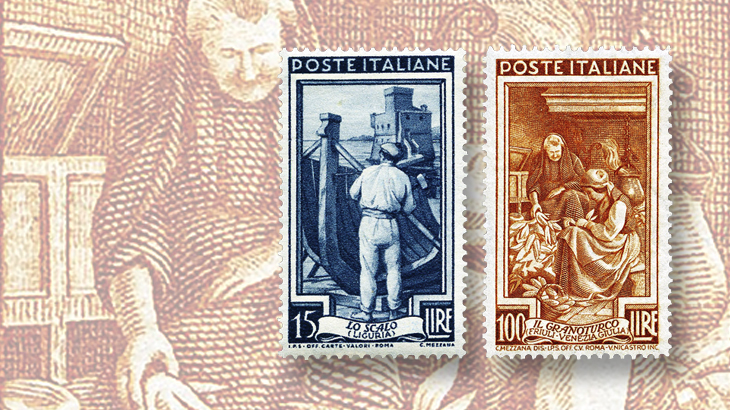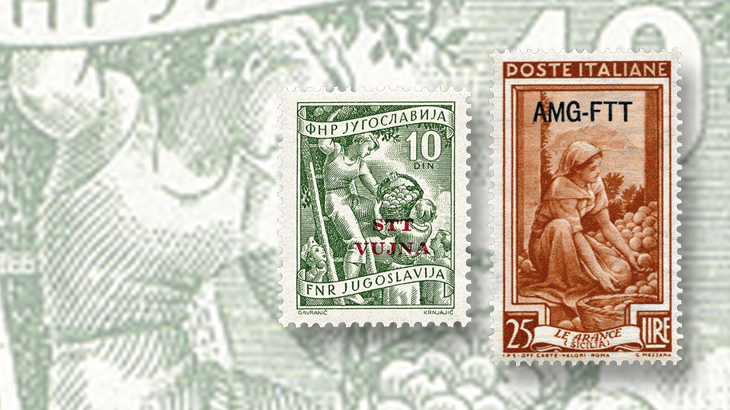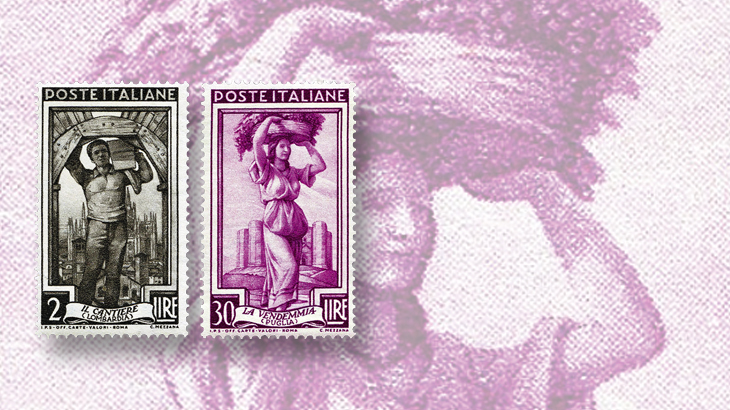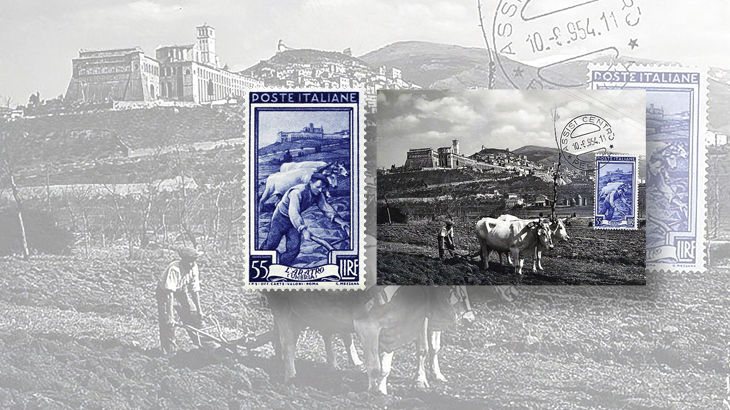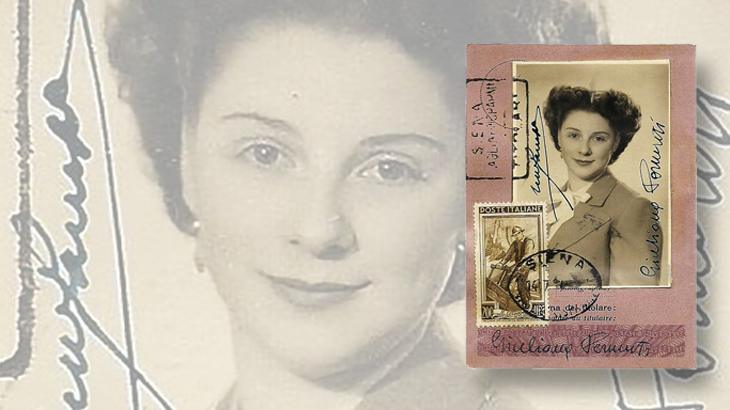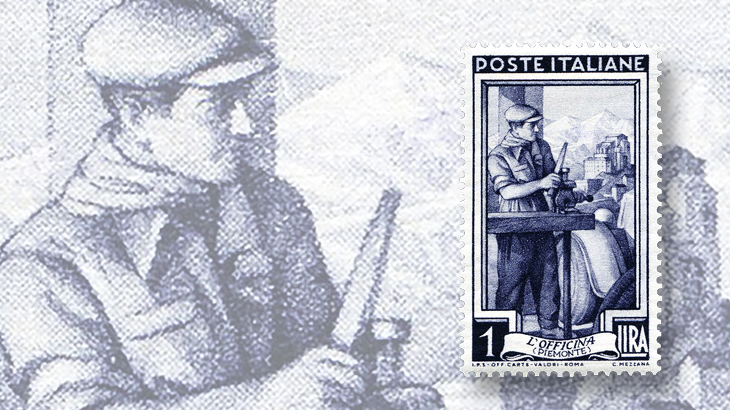World Stamps
1950-58 Italy at Work series: timeless stamps honor ceaseless toil
By Fred Baumann
The Italia al Lavoro series of pictorial definitives came upon the scene Oct. 20, 1950, as a series of 19 vertically formatted, monochrome pictorial definitives (Scott 549-567).
Denominated from 50 centesimi to 200 lire, the 24-millimeter by 40mm stamps were initially printed in sheets of 50 on paper with one of three Winged Wheel watermarks at the State Printing Institute Office of Securities in Rome.
Despite scrolled inscriptions and superlative imagery on the 17 rotogravure stamps and the two engraved high denominations, these stamps are regarded as definitives.
They replaced Italy’s rather tired postwar Democratica definitives that had been in use since 1945 (Scott 463-476), and were issued in an array of denominations to meet any conceivable postal rate or requirement.
Connect with Linn's Stamp News:
Like us on Facebook
Follow us on Twitter
Keep up with us on Instagram
Although categorized as definitives, the stamps also can be regarded as among the most thoughtfully conceived and rigorously executed commemoratives ever issued, and their genesis and unusual dual nature is worth exploring.
Looking at the full set at one time is not the best way to start. As with the United States 1898 Trans-Mississippi pictorial commemoratives (Scott 285-293), seeing all of them at once means missing much of what makes each individual stamp great.
ITALY AT WORK DESIGNS
The name of the issue, “Italia al Lavoro,” is rendered in English as “Italy at Work.” If you look at the stamps as commemoratives, what they celebrate are the millennia of labor that built Italy.
The workers are painstakingly depicted with a grace and gravitas that recalls the most appealing aspects of the fine arts of ancient Rome, but each stamp design shows that what has mattered most down through the countless generations has been the work itself.
Each stamp displays characteristics that unite them, beginning with the text in the scroll at the base of each design, which tells us the name of the job and one of the 19 regions of Italy where the scene is set, most with a specific distinctive regional landmark or activity in the design.
On the 1-lira denomination (Scott 550), the inscription is “L’OFFICINA / (PIEMONTE).” The former means “the workshop” where the mechanic on the stamp is hard at work, while the “Piedmont” (literally, foot hills) refers to the northwest corner of Italy at the base of the Alps where it meets Switzerland and France.
Indeed, through the open garage door we see shining snow-clad mountains and, in the near foreground, buildings ascending steep streets. In the middle distance is the Sacra di San Michele, or St. Michael’s Abbey, a religious community dating from the 10th century, acknowledged by regional law as the “symbolic monument of the Piedmont region.”
With all that history and culture, why is the man in the foreground working on a car, filing away at a part clamped to his workbench? That’s because the regional capital and principal city of the Piedmont is Turin (Torino), the birthplace in 1899 of Fiat, which today owns Alfa Romeo, Ferrari, and Maserati, and is allied with Chrysler. (The “t” in Fiat stands for “Torino.”) A decade after this stamp was issued, the city became the home of Italy’s National Automotive Museum.
As another example, the 55-lira Plow stamp for Umbria of central Italy is pictured next to a 1954 maximum card from Assisi with a photograph showing an almost identical scene. In both, a plowman follows his oxen across a rutted field below the town of Assisi and the magnificent Basilica of St. Francis, mother church of the Franciscan Friars.
The basilica and the associated buildings were declared a UNESCO World Heritage Site in 2000. The men in this region have raised beef, corn, and hay for three millennia.
That is what you can find on one of these stamps. The complete set is a full-blown nationwide tour, deftly integrating cultural, religious and technological history and landmarks, that fits neatly on one page in your album. For definitives, one might say these stamps are exceptionally commemorative.
STAMP DESIGNER CORRADO MEZZANA
Much of their magic came from the brilliant mind and the remarkable talent of Corrado Mezzana, seen here on a 1990 600-lira Stamp Day commemorative honoring the centennial of his birth with a self-portrait stamp (Scott 1826). You’ll note that the frame of the portrait echoes that of the Italy at Work definitives, the greatest of his many achievements as a stamp designer. A collection of stamps designed by Mezzana would be attractive as well as substantial.
Mezzana had a lifelong fascination with art, cultivated by the best schooling and enhanced by abundant ability. Among his many professional successes, he designed postage stamps for Italy as early as 1930, and produced a prodigious number of striking issues through the 1930s and 1940s for Vatican City and San Marino as well. Exhibits of many of his philatelic designs are displayed in the postal museums of both Rome and the Vatican.
There is no clear-cut documentation publicly available of which I am aware, but it seems that much of the initiative as well as all of the original artwork in the Italy at Work definitives came from Mezzana, whose name appears at the bottom on every stamp.
My two favorite Italy at Work stamps showcase Mezzana’s exceptional artwork and creativity: the 2-lira Cantiere (Construction) stamp representing Lombardy in populous north-central Italy (Scott 551), and the 30-lira La Vendemmia (Harvest) stamp for Puglia.
The former is framed by joinery around a high window as he enters to begin building. As if to underscore the eternal nature of that occupation, behind him we see the fantastic spires of the Milan Cathedral, the fifth-largest church in the world, and one that took almost 600 years to finish. All that work, over two dozen generations, was accomplished by humble, hardworking men such as this one.
The Harvest stamp depicts a maiden whose lineage and labors are older still: She could have stepped off a Roman road 2,000 years ago or more. She balances on her head vines sagging with the heavy fruit of late summer vineyards, as she passes Puglia’s Castel del Monte, an octagonal structure built by Emperor Frederick II in 1240, in the background.
PERFORATIONS
These stamps are easy to enjoy, but can be a considerable challenge to collect.
Scott records that the 17 lower Italy at Work denominations (Scott 549-565) are perforated gauge 14. The 100-lira and 200-lira high denominations (566-567) are perforated gauge 13 by 14 and 14 by 13. Also, the 100-lira denomination exists perforated gauge 13 (566a) and gauge 14 (566b), and the 200-lira stamps exists perf 14 as well (567a).
For those seeking to specialize, Italy’s Sassone specialized catalog (Catalogo Specializzato Dei Francobolli D’Italia e Dei Paesi Italiani) lists a great many more issued varieties to track down, including elusive perforation gauges and combinations, some of them very scarce.
This catalog records the perforations of the 50-centesimo to 65-lira stamps (Sassone 634-550) as perforated gauge 14¼ by 14. The question of how many different perf varieties actually can be found on these stamps is far from a settled matter. Although many are easily found, some are extremely elusive, and the total number might not yet be known.
Active in English stamp clubs for 40 years, Tony Clayton is a lifelong collector specializing in Italy, Trieste, and Italian Colonies, and is the sales circuit director of the United Kingdom’s Italy and Colonies Philatelic Society.
He maintains a marvelous and well-illustrated website on Stamps of Italy and Italian Colonies, www.italianstamps.co.uk, and has posted extensively on the varieties of the Italy at Work definitives on the stampboards.com Postage Stamp Chat Board & Stamp Bulletin Board Forum.
On a Stampboards post (www.stampboards.com/viewtopic.php?f=13&t=29880#p2219460), Clayton records 100-lira perf varieties of 14¼ by 14¼, 14 by 14, 13¼ by 13¼, 14¼ by 13¼, 13¼ by 14¼, 14¼ by 14, 14 by 14¼, 14 by 13¼, 13¾ by 13¼, 13¼ by 14, and an extremely rare perf 12¼ by 13¼, of which only one used horizontal pair has ever come to light.
The 200-lira high denomination also is recorded by him as perforated 14¼ by 14¼, 14 by 14, 13¼ by 13¼, 14¼ by 13¼, 13¼ by 14¼, 14 by 13¼, and 13¼ by 14.
Both high denominations also exist mint and used in two rare compound perforations: 14¼ by 11¼ by 14¼ by 13¼, and 14¼ by 13¼ by 14¼ by 11¼.
WATERMARKS
Then come the watermarks, and here the collecting gets complicated. When originally issued in 1950, the stamps received one of three similar but distinguishable Winged Wheel watermarks (Scott watermark 277), which Clayton devotes a well-illustrated page to on his website, www.italianstamps.co.uk/wmk/index.html.
Winged Wheel watermarks on a wide range of these stamps are known reversed, inverted, and reversed and inverted. All these variations also are flipped left to right, as well as in the normal configuration, and there are three different types of these Winged Wheels.
Then, in 1955-57, new Stars watermarks were introduced on the 20-centisimo, 1-lira, 2-lira, 15-lira, 30-lira, 50-lira and 65-lira Italy at Work stamps (Scott 668-673A, watermark 303). Again, there are multiple configurations. Type I Stars “are sharp and clear, and aligned horizontally or vertically,” Clayton notes, adding that some “show lines indicating that the paper is laid.” All seven of these later stamps have Type I Star watermarks.
Type II Star watermarks, found exclusively on 15-lira Italy at Work stamps , “are slightly less sharp and clear, and aligned at an angle,” according to Clayton. The angle for the 15-lira stamp is 25 degrees, but the stamp can again be flipped, yielding two collectible varieties.
Very small quantities of the 50-centisimo, 15-lira and 25-lira stamps are known without watermarks, and are highly valued, especially the 25-lira.
Other major errors include the vertically imperforate horizontal pair of the 100-lira stamp with gauge14¼ perforations shown nearby, listed in the Sassone catalog as 651lk with a catalog value of €2,750 (US$2,993). This mint pair realized $950 as lot 601 in a November 2006 sale at Cherrystone Auctions Ltd.
ON COVERS
A great resource for studying these and other Italian stamps is Fil-Italia, published quarterly in the United Kingdom since 1974 by the Italy and Colonies Study Circle.
One of its best articles for collectors of the Italy at Work definitives, written by Robert Johnson and published in the March 2004 issue (Vol. XXX, No. 2, pages 80-85), is unfortunately titled “The Lavoro Issue of October 1950.”
What makes the title unfortunate is that Johnson’s article actually is about the many different postal rates that the various stamps paid, some of which are quite uncommon, with illustrations of eight relevant covers and a description of how each was rated.
A collector seeking to independently establish these rates could spend years doing the legwork to gather the information helpfully distilled into this one brief overview. Johnson notes, for example, only one post office application for a single franking of the 200-lira high denomination (Scott 567): post office identification cards. In the example shown with this column, the stamp is tied by a special Siena datestamp from 1952 to the photo on the inside front cover of this postal identity card for one Giuliana Permuti.
While many of the stamps should be easy to find on cover, finding others could be the work of a lifetime. For example, although it is readily found on covers in combination with other stamps, the only valid single franking for the 2-lira Italy at Work stamp is to pay the second step in domestic braille mail for the blind.
However, in general, because these stamps were definitives and were in use for most of the 1950s, they are relatively easy to find on collectible covers at affordable prices. For example, a 1952 commercial express letter from a business in Milan to Gevelsberg in Westphalia, Germany, franked with six Italy at Work stamps paying 135 lire for postage and express fees, was recently offered for the equivalent of $8.70. That postal identity card was only $25.
OVERPRINTS
When World War II hostilities ended near the disputed city of Trieste at the upper end of the Adriatic Sea, Italy under Anglo-American occupation held Zone A — a narrow strip including the ancient port itself — and Yugoslavia controlled Zone B to its south and east. Each had ambitions to annex the neighboring territory, and each issued overprinted definitives for use in the patch it controlled.
At the same time that it introduced the stamps domestically, on Oct. 20, 1950, Italy also issued Italy at Work definitives overprinted “AMG-FTT” (“Allied Military Government – Free Territory of Trieste”) for use in Trieste Zone A (Scott 90-108).
In 1953, Yugoslavia replied by overprinting “STT-VUJNA” (“Free Territory of Trieste – Military Administration Yugoslav Army”) on its National Economy definitives, which also pictured workers. Shown with this column are two of the stamps: the 10-dinar Yugoslavia stamp depicting four workers picking apples, and the 25-lira “AMG-FTT” Italy at Work stamp showing a woman sorting the famous blood oranges of Sicily. Out her window is the distinctive outline of Mount Pellegrino, across the harbor of Palermo.
As to which is better, you be the judge — unless you think it’s a matter of apples and oranges.
My sincere thanks to Mercer Bristow, the reference collection, and educational resources of the American Philatelic Society, without which this column would not have been possible.
MORE RELATED ARTICLES
Headlines
-
US Stamps
Oct 7, 2024, 3 PMMcMurtrie dismissed as APS education director following Sept. 21 arrest
-
US Stamps
Oct 7, 2024, 12 PMVasiliauskas named president of Mystic Stamp Co.
-
US Stamps
Oct 6, 2024, 5 PMApgar souvenir card available
-
US Stamps
Oct 6, 2024, 4 PMFirst Continental Congress and U.N. stamps receive Scott catalog numbers
